
It's the southern hemisphere, beyond the tropics! It's there the kingdom of those constellations the northerners may just have a glimpse of. Southern hemisphere countries are found in South America, southern Africa, Australasia and the Pacific. From the mid-latitudes of a given hemisphere, a observer mostly will be able to observe a 3/4 only of the whole celestial sphere. To observe the remaining, he will to move South or North
| Observational Environment Southern Skies Specifics | Observing |
(note that this section is the same than the one found at "Naked-Eye Sky Learning 1 (Northern Hemisphere)")
Best possible naked-eye sky learning environment is a free 360° horizon. If not, a backyard is useful anyway. Or even a balcony or a simple window. Even if you see less stars and if you have to learn the sky "slice by slice", you will learn anyway. The most important tip is that your eyes progressively get used to the darkness hence progressively see more stars. This is a well known rule of amateur astronomers. Once in a session, just avoid to expose yourself back to any source of light. Should you have to use any documentation as often the case, just use a red flashlight or use the night vision toggle of your planetarium software. Red flashlight are easily found at amateur astronomy retailers or you may easily tweak one: just find a red-tinted bulb, or paint one, or place any convenient red filter on the flashlight. Should you observe from a city or a building, street lamps or other light sources will surely be unwanted sources of light. Just find the appropriate angle which will elude them and just avoid to expose you back to the sources during the observation session
Another point is that you just have to be comfortable while observing. First, you may observe standing, or sitting on a chair or an armchair, at your convenience. On the other hand, always think about how you will get clothed. Observing is always best done in open air (or with a window opened) and some nights may be cold! Dress accordingly and wear appropriate protections like gloves or good shoes, if needed. You have to feel comfortable. By summertime, be mindful of insects! In case, just warn your neighbours that should they see a strange shadow with heavy woollen hoods on the head, it's just you learning the sky ;-) A last thing too: should you decide to go to some dark place outdoor to have a better horizon, just think in terms of safety first. Dark places, reasonably, are not the safer places around!
Celestial mechanics, South, is apparently inverted, as the night sky, there, seems to be revolving around a point located South. This daily motion around the south celestial pole, further, is occurring clockwise -as counterclockwise North. The Earth, however, keeps revolving from West to the East, in the southern hemisphere as it's only the resulting sky's apparent motion which is different! Another most striking southern feature is that the celestial objects are seen upside-down! Mare Crisium, on the Moon, thus, is seen left of the lunar disk as the southern lunar pole is atop the disk! That's true too for the Sun and the planets. This is mainly due to that the ecliptic is North of the observer, as North, it's South. One is somehow 'beyond' the ecliptic, in the southern hemisphere! Another characteristic consequence of that is that, in the southern hemisphere, even if the Sun rises East and sets West, its course in the sky makes hit to head over to the northern horizon (and not the southern one like in the northern hemisphere!). Once risen, the Sun is heading towards the northeast -and not the southeast! From the North then, its journeys back, in oblique, to set to the West. That, further, is true too for the course of the planets during the night because that specific course of the Sun northwards is due to the location of the ecliptic there, as seen from the southern hemisphere. The planets, too, are seen along the ecliptic. Northern constellations, at last, which are seen South, are seen inverted too. Leo, the Lion or Bootes, the Herdsman are so, as Sirius, for example, is lying to the upper right of Orion. Another feature, South, is that the northernmost northern constellations, like Ursa Major -with the asterism of the Great Dipper, or Cassiopeia, are not observable. The observer won't forget either that the seasons, in the southern hemisphere, are at the opposite of those seen North, with when it's summer North, it's winter South, and reciprocally!
The distinctive feature of the southern skies is a remarkable band of Milky Way-embedded, typically southern constellations, which runs from Canis Major, the Great Dog to Aquarius, the Water Bearer. That band is taking various positions relative to the south celestial pole, along the seasons. As, in winter, it's vertical and right of the south pole (West), it's -in a remarkable way- low, all along the southern horizon in spring. During summer, it's back to vertical, but left of the pole this time (East). In fall, at last, it's at its best visible, horizontal above the southern horizon. Circumpolar southern constellations harbour 6 first magnitude stars, as the southern skies are the only locations at Earth where you'll be able to see the Large, and the Small Magellanic Cloud
| Crux and Canopus Winter Sky Spring Sky | Summer Sky Autumn Sky |
The southern skies are, at the same time, the skies which the northerners could get a glimpse of, from the northern hemisphere, and the skies which were devised by the European explorers from the 16th century onwards. The southern hemisphere sky, in an accessible way, is providing the finest parts of the Milky Way. Just like North, due to the alterning seasons, one can say that there is, South, a sky typical of winter, spring, summer, and fall, respectively, as at each of them, due to the location of the Earth on its orbit, we're looking to a specific part of the nocturnal sky sphere
For any observational purpose, you will have to learn what part of the sky is at your disposal. As a rule of thumb, should you usually see the sun setting, this means that you observation post if facing West. Should you usually see the Sun rising, you are facing East. About midday, Sun is about your South. Hence North is in the opposite direction. A better way to find too is to use a chart, or a compass. Don't forget too that seasons, South, are the opposite of those seen North. Winter runs June-September, as spring September-December, summer from December to March, and fall from March to June. Just remember too that, when you look to the south celestial pole, East is to your left, as West to your right!
The logics for our night sky learning training, as exposed herein, is a logics usually admitted by the amateur astronomers community. It's mostly based on the use of two sky charts, a one concerning the western, and the other the eastern horizons. The trainee thus will just have to follow, charts in hands, our text as our method mostly is juxtaposing and descriptive. That means that you will have to spot the constellations from the charts, and to follow our descriptions! Of help to check you identify well constellations, are some softwares useable with your smartphone -- some advanced and also used with a computerized telescope. That works by pointing the smartphone in the direction of a constellation and having its name, bright stars, etc. You will also note that, as far as our site's charts are concerned, they do not bear, by a worry of legibility, any name of the bright stars. As our description refer to such names, just consider that those mostly are, on the chart, the brightest star of the constellation in question
Observations tips are given for night's first part, that is about 10:30 p.m. local time. 'Season' is understood like the time about the middle of it, like, for example, about early November for spring. Color maps with Stellarium. Printer-friendly charts with Cartes du Ciel, Patrick Chevalley. The illustrations for the 'Crux and Canopus' section are hand-drawn composites. Each night, the celestial sphere is shifting to the western horizon by 15 degrees per hour. From one month to the next, for a same latitude, a star or constellation will be found back at the same position in the sky with 2 hours earlier. By winter in the southern hemisphere, Earth's nightside is directed towards our Milky Way Galaxy's interior, making the season the best to observe deep sky objects, as some galaxies are also at reach. Mid-fall is the best season for galaxies only
->Caution! A current tendency of the astronomical softwares and charts is to shift from the constellations' shapes as they are usually defined and recognized by the amateur astronomy community. The following color charts on this page are those which are shifting the most in this regard, as the printer-friendly charts are those who do less and are the ones to be used to memorize the basic shapes of the constellations, albeit still not completely accurate. read more!
(note: the data, in terms of dates, as far Crux, the Southern Cross and Canopus are concerned, may vary function of whether a DST system is enforced, or not, from where you are observing)
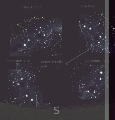 | click to where Crux, the Southern Cross is along the seasons |
As the Great Dipper and Polaris allow to spot the celestial pole -hence North- in the northern hemisphere, the southern hemisphere is lacking such easy beacons. The famed Crux, the Southern Cross just fix that, in an imperfect way however. Crux is a cross-shaped constellation as the main axis of it is pointing to the south celestial pole. Should you want to find Crux, just turn South! Remember: South is left of where the Sun is generally setting (or use a compass)! Crux, the Southern Cross is a small constellation which is to be found in the Milky Way. Its shortest length equals the distance which separates both stars located each side of Altair, in the constellation Aquila, the Eagle. Crux' main axis is pointing South! (the southern celestial pole is located at 4.5 times the g-a distance, beyond a). The main inconvenience with Crux is that the constellation isn't visible during a relatively lengthy part of the year, as it passes under the southern horizon, from September 10th to about December 25th and that there's no alternative method. A helpful feature however may reside into the bright Canopus, along with Crux' axis. Canopus is the star a Carinae. It's located at a quarter sky length from Crux, and at the same distance from the south celestial pole than it (in both accompanying charts, Canopus is the brightest star, the two stars nearest to Crux, the Southern Cross excepted). Now, imagine a line which leaves Canopus, intersecting at a 90° angle the line determined by Crux' axis. The intersection is just the south celestial pole! Canopus however, as far as it is concerned, is not observable neither from after the beginning of June to the beginning of October. Hence southerners are just left with Crux and Canopus from the end of December to the beginning of June, and with Crux only from the beginning of June to September 10th. They, at last, are left with no hint to the southern celestial pole between September 10th and the end of December
 | click to Crux and Canopus along the seasons (for the constellations' shape, if needed, see at the appropriate seasons) |
The sky, during winter, in the southern hemisphere is not devoided of interest, with southwest and West, the Milky Way-embedded southern constellations running, North, the Summer Triangle seen, and East, typically southern constellations. Let's turn West. See how, from the southwest up to near the zenith, a vast band of constellations is running, with the Milky Way in the background. That's the distinctive feature of the southern skies! Let's have a closer look to what those constellations are, during the southern winter. Relatively high already, you'll find Crux and the Pointers. Crux, the Southern Cross, is, obviously the iconic constellation of the southern hemisphere, as what the amateur astronomers are calling 'the Pointers' are two bright stars 'pointing' to Crux. The Pointers now are southwest, high. The highest of both is Alpha Centauri, as the one below is Agena (or b Cen). Now, just follow the direction given by those stars, in that direction, and you'll necessarily find Crux, the Southern Cross. Crux is just a small cross, and, interestingly, the smallest of the constellations in the sky! Crux, the Southern Cross is unseen for any observer living above 35° North. Another sight of interest is that dark patch in the Milky Way, at the tip of the main axis of Crux. It's the famed 'Coalsack', an intervening interstelar cloud of dust and gas which masks the stars behind. When we told, above, 'Alpha Centauri', you just thought that you already knew that name. Indeed, Alpha Centauri is nothing else than 'Proxima Centauri', that star which is the nearest to our Sun, at 4.35 light-years. 'Proxima', in Latin, has the meaning of 'closest to'. The fainter region which is located between Crux, the Southern Cross, and the horizon, is belonging to the constellation Carina, the Ship's Keel. As Lupus, the Wolf is of interest by itself, the next main sight, now, albeit much high in the sky, is Scorpius, the Scorpion. Scorpius is one of those constellations which accurately figures the animal, or concept, it's supposed too. Just see that tail, high, and the head, figured by that bright star which is Antares. The figure, during the Antiquity, was more striking still, as the Ancients did not have the fainter Libra, the Scales, below, like and independent constellation. Those stars instead were the scorpion's claws! While we are West, the bright star nearing the horizon is Spica, of constellation Virgo, the Virging. Corona Borealis, the Northern Crown, northwest, albeit some low, is a fine sight. Hercules, the Heroe, at last, is a fine field. The constellation, which is looking like a central quadrilateral, with extensions starting there, is harbouring the famed globular cluster M13, 'the Great Cluster in Hercules', a fine binocular object, at the 5.9th magnitude. M13, now is found on the lower side of the quadrilateral, at one-third the length, from the star at right. The central quadrilateral of Hercules is an asterism per se, which is called the 'Keystone'
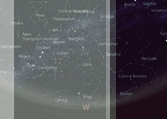 | 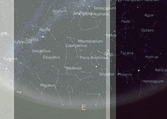 | click to winter sky, southwest, West (left) and East (right). retrieve printer-friendly charts (southwest, West, East) |
Let's turn East, now! The sky there is of interest, with the whole southeastern part of the sky filled with typically southern constellations. Just have some look! As the bright star there is the famed Achernar, there where Eridanus, the River is ending its meandering course, and as the Small Magellanic Cloud is that remarkable object higher still, in Hydrus, the Water Serpent, just have some fun and spot such varied constellations like the faint Sculptor, the Sculptor, Phoenix, the Phoenix, Grus, the Crane, with the bright Alnair, or Tucana, the Toucan. Indus, the Indian, and Pavo, the Peacock, are near the zenith. Fine sight, and a fine training to train you to spot constellations. Capricornus and Aquarius, two zodiacal constellations, are seen East, as it's about the best time to observe Aquarius, the Water Bearer. The bright star, slightly to the upper right of Aquarius, is the famed Fomalhaut, of Pisces Austrinus, the Southern Fish. 'Fomalhaut', in Arabic, means 'the fish's mouth', 'Fum al-Hut', which translated into 'Fomalhaut'! As we come near to the northeastern parts of the sky, we're approaching that distinctive feature of the Summer Triangle, to which we'll head in a few moments. High, Sagitta, the Arrow, Delphinus, the Dolphin, or Equuleus, the Little Horse, are fine, small constellations to see
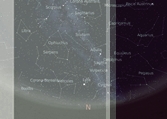 | click to winter sky; the northern hemisphere, summer sky, Summer Triangle. retrieve a printer-friendly chart |
We'll end our first journey in the southern skies with the northern horizon! Just turn North! You cant' miss that figure of a large triangle of three stars, one high in the sky and both the others closer to the horizon, below. This is the Summer Triangle. This figure is called like that because, first, it's a triangle, and then because it's the distinctive feature of the sky, in summer, in the northern hemisphere. As, here, in the South, we're now in winter. Up there, in the northern hemisphere, they do have their vacations and it's summer. Hence they are seeing the Summer Triangle, South! The three bright stars of the Summer Triangle are, from the highest to the one at the lower right, Altair, Vega, and Deneb. Those are the main stars to the constellations Aquila, the Eagle, Lyra, the Lyra, and Cygnus, the Swan. The constellation Aquila is usually seen just like the two stars either side of Altair, as Lyra is the small quadrilateral affixed to Vega, and Cygnus is cross-shaped. Northwest, you can find back Hercules, the Heroe, as the vast constellation, high, is Ophiuchus, the Serpent Holder, which is the personnification in the sky of Asclepios, the Greek god of medicine. He is surrounded by his two serpents, which he used like his herb-finders
The first main distinctive sight -if a sight- in spring in the southern hemisphere is that the Milky Way, hence the Milky Way-embedded southern constellations, is just lying all around the horizon! Should some observer gets at his disposal, a plain, 360-degree view from his post, he could see how amazingly the Milky Way is just all around! A much fine sight, some bite more preeminent to the southwest. There, with constellation Sagittarius, the Archer, as the tail of Scorpius, the Scorpion is hanging over the horizon, any observer with some open horizon will just have the center of the Milky Way Galaxy. It's there that the bulge of old, yellow stars which form the core of the Milky Way Galaxy is located. When looking toward the Milky Way galaxy center, dark patches seen are dense dust clouds in a inner spiral arm of our Galaxy blocking our view of stars toward the center. As there too is lurking a Mercury's orbit-wide, tremendous galactic black hole, those places of the highest density and gravity in the Universe! Caution! Keeping South, you can't miss either the both Magellanic Clouds, those satellites to the Galaxy! They are beginning to be at their best! Barely southwest, from South, and not that much high above the horizon, Triangulum Australe, the Southern Triangle is see, a fine sight, with Pavo, the Peacock above. West, high, you'll find Capricornus, the Goat as Equuluus, the Little Horse, and Delphinus, the Dolphin seen northwest, fine small constellations
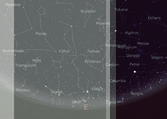 | 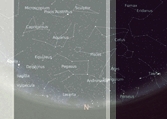 | click to spring sky, eastern horizon (left), and the Great Square of Pegasus (right). retrieve printer-friendly charts (eastern horizon, the Great Square of Pegasus) |
Further sights are of interest East. The show there is provided by the bright Canopus, southeast, the ornament of constellation Puppis, the Ship's Stern, a remarkable star. See the small Columba, the Dove, to its left, or Pictor, the Painter, another small constellation above. Dead East, another much fine view is the one of Eridanus, the River, taking at a bright star, and heading a long way into the sky, to the southeast and the zenith! Eridanus, the River was considered a celestial river by the Ancients, and maybe even the Nile river. The bright star at which it takes is Rigel, of Orion, the Hunter (those with a plain horizon will get the upper part of Orion, which is just lying on the horizon. Note, above the three stars aligned, this faintly glowing object, which is the Orion Nebula). Then the celestial river is meandering a long way in the sky, an inspiring sight. Eridanus is ending its course to that bright star, Achernar, which, in Arabic, means 'the end of the river'. Taurus, the Bull, northeast, with Aldebaran lying among the V-shaped cluster of the Hyades, and the Pleiades, that small, famed cluster, is to its left, another fine view. Above and high is Cetus, the Whale, which is taking at one bent of Eridanus. Cetus, the whale was a sea monster which attacked Andromeda and which was subdued by Perseus through the head of the Medusa. The last show to see, during spring, is on the northern horizon. Just turn North! With the Great Square of Pegaus, Pisces, the Fishes, and Andromeda, Andromeda, that's a good way to keep discovering the sky. The Great Square of Pegasus is a fine view, a large square of stars, one of them, currently the one at the lower right, belonging to Andromeda. Andromeda, Andromeda, is that line of stars taking at the Great Square and heading northeast, to the horizon. A fine sight! Andromeda, of course, is famed as the constellation is harbouring the Andromeda Galaxy, or M31. That large, spiral galaxy is just giving us a view of how our own Milky Way Galaxy would look, could we see it from the outside, a vast and fine spiral galaxy, with a bulge of old stars to which blue arms of younger stars are taking. M31 is an easy binocular object -and even a naked-eye one- at the 4.8th magnitude. The star-hopping move to find it is easy: just find the second, relatively bright star from the corner of the Great Square of Pegasus, on the line of Andromeda, go to the lower left, spot a fainter star, then, in that same direction, a fainter still, and here you are! You've found M31. The Andromeda Galaxy, on the chart, is that faint, nebulous oval! We'll end that spring tour with Pisces, the Fishes, high, framing both parts of Pegasus and Andromeda. The loop of stars, high, is an asterism and called the Circlet, as the constellation is a long chain of faint stars. Aries, the Ram, or Triangulum, the Triangle are in the field too and interesting to know
At the opposite of what was seen during last winter, you'll note that the long band of Milky Way-embedded constellations is now seen southeast, as, South, the Magellanic Clouds keep being at about their best as the other horizons are of interest too, and with the northern one providing the sight of the northern hemisphere great winter sky, about Orion, the Hunter. Let's begin our tour of the summer night sky! Just turn East! Like we said, the long, Milky-Way band of embedded southern constellations is now just taking about southeast and heading over your head, to that bright star, which is Sirius, of Canis Major, the Great Dog, the sky's brightest. See how you find back the Pointers (Alpha Centauri now is under Agena), which keep pointing to Crux, the Southern Cross. Renewed fine views! What's new now is that, beyond Crux and further limited by Canis Major near the zenith, are lying vast expanses of sky, which one were a sole and immense constellation. It was, there that, during the Antiquity, the astronomers were seeing the Ship Argo, that ship that the Greek heroes, around Jason, did use to go in quest of the Golden Fleece, and that they maybe eventually found there in Georgia, along the Black Sea. That gigantic constellation, during the Modern Times, for observational purposes, was just divided into three. That leads to that, today, we're seeing Carina, the Ship's Keel, Vela, the Ship's Sails, and Puppis, the Ship's Stern, in that order, from Crux to Sirius. Fine reaches of sky, with, at the zenith, that other bright star, which is Canopus, of Carina. And that's not all! Lying along the band, a row below however, see that fine view of Hydra, the Hydra, which is finely ending into a small loop of stars. Near the loop, a faint constellation is Cancer, the Crab, a constellation which is famed for harboring M44, a fine open cluster, also said Praesepe, or the Beehive. M44 is just close to the two central stars of the constellation
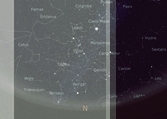 | click to summer sky, northern horizon. retrieve a printer-friendly chart |
We're now going to consider the northern horizon. Just turn North! Here's another show of interest. We are just facing what the northerners are calling 'the great winter sky'. As we are in summer, South, the northerners, up there, are having their winter. And, to their South, they are having that great ensemble of bright stars and constellations, ornating those cold nights of winter, as this 'great winter sky' is the equivalent for the northern winter of what the Summer Triangle is for the summer there! The central piece to the great winter sky is Orion, Orion. Orion is just a great quadrilateral of stars, with three stars aligned in its center, and easy to find. The three stars are called the 'Orion's Belt'. Orion, the Hunter, is currently lying high. Starting at Orion, and using a set of alignments of its stars, one may find one's direction into that part of the sky. If one extend the Orion's Belt to the upper right, one reaches Sirius, and Canis Major, the Great Dog. If one extends it to the lower left, one find Aldebaran, among the V-shaped, loose cluster of the Hyades, and, further still, the small and remarkable Pleiades. Should one consider the line between Rigel (the star to the top left of the quadrilateral) and Betelgeuse (the one to the bottom right), and that one extends it downwards, one find Gemini, the Twins, another quadrilateral of stars, with Castor and Pollux. Two other fields are of interest in that great winter sky, with this other bright star, above Gemini. It's Procyon, of Canis Minor, the Little Dog. That name was given to the stars as it was see ahead of Sirius, of the Great Dog, meaning, in Greek 'with comes ahead of the dog'. Another bright star, low, to the lower right of Taurus, is Capella, with another fine constellation, Auriga, the Charioteer. All in all a fine 'northern' sky!
Let's keep the journey West and South now! West, it's a favourable moment for Cetus, the Whale, dead West, as, high, one finds again Eridanus, the River, that celestial river, maybe the Nile for the Ancients, as it's taking its source to Rigel of Orion, Orion, and meandering a long way, down to that bright star Achernar, which currently is seen southwest. Tucana, the Toucan, and Phoenix, the Phoenix are in the neighbourhoods. Frankly South, the two Magellanic Clouds keep being at their better. The Large and the Small Magellanic Clouds are satellite-galaxies to our Milky Way Galaxy, similar to those companions which are seen along the Andromeda Galaxy. Both the Magellanic Clouds are circumpolar, that is that they are visible all year round, never descending under the horizon. They are owing their names to the Spanish explorer Magellan, who was the first, in the 16th century, to perform a round trip around the world. It's likely he was the first ever to see those celestial objects! The Large Magellanic cloud (LMC) is about 5-degree wide. It's located at the border of the constellation Dorado, the Swordfish. The Small Magellanic Cloud (SMC) is 2-degree wide, as it's the constellation Tucana, the Toucan. The Large Magellanic Cloud is so important that even a bright Moon doesn't hinder its sighting
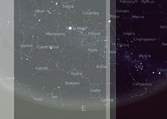 | 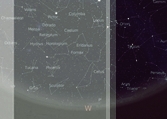 | click to summer sky, Hydra, the Hydra (left); the western horizon (right). retrieve printer-friendly charts (Hydra the Hydra, the western horizon) |
Fall, in the southern hemisphere is providing a dramatic view. It's South that the observers mostly will turn at that season, with all the southern constellations embedded in the Milky Way are running, ininterruptly, from the East, to the West, arching high over the southern horizon. A remarkable sight, to be seen nowhere else in the world! Just turn South! High above, check those two bright stars! Aren't they the Pointers? Yes, they are, and follow the line. Yes! They really are pointing to Crux, the Southern Cross! What a sight. The Southern Cross just hanging South! Remarkable! And, from the East, from Scutum, the Shield and Sagittarius, the Archer, down to the West, with Sirius and Canis Major, the Great Dog, see how all those great, typically southern constellations are unfolding! Let's take them from Scutum! With Ophiuchus, the Serpent Holder above, and the frightening sight of Scorpius, the Scorpion, here is just, in Sagittarius, the Archer, the center of the Milky Way Galaxy! Tremendous sights! Our Milky Way Galaxy is one of those spiral galaxies like popularized by the media, a large, pinwheel-like galaxy, with a bulge of old, yellow stars at its center, and spiraling arms of blue, younger stars, taking at this center. As we are living, with the Earth and the Sun, inside such a galaxy however, we can't seen our Milky Way Galaxy under its form of a spiral. We are just seeing it like the Milky Way instead. Simply. That means that, as, with the Sun, we're lying relatively far from the center of the Galaxy, when we are looking, either side of our position, in the plane of the Milky Way Galaxy, we are seeing the Milky Way -which thus is the Milky Way Galaxy edge-on- as, when we're looking at a 90-degree angle from the plane, with are seeing looser fields of stars and constellations (and, by the way, allowing to peer deep into the Universe, outside our own Galaxy home!). And there, with the center of the Milky Way Galaxy, in Sagittarius, we are looking in the plane of the Galaxy, and towards the center of the spiral. And here, that gives up those profound draperies and glowing fields, and with those dark, interstellar clouds of gas and dust. Here is the bulge of yellow old stars. Here is the center of the Galaxy! When looking toward the Milky Way galaxy center, dark patches seen are dense dust clouds in a inner spiral arm of our Galaxy blocking our view of stars toward the center. And, beyond it being that tremendously looking view, the center of the Milky Way Galaxy, like the astronomers now know for most of the galaxies, is featuring in its very center a large, galactic black hole, the size of the orbit of Mercury! A black hole, generally, is a place of the highest density and gravity in the Universe. Such locations are so dangerous and trapping everything in the neighbourhood, that not even light, with its highest speed in the Universe can get out of there! So, beyond those draperies and dark lanes, there such a black hole, of a galactic size! But, let's keep along the trail! Ara, the Altar, and Lupus, the Wolf, are fine fields. Passing back to the Pointers, with the constellation Centaurus, the Centaur and Crux, the Southern Cross. Now heading West, where those with a completely plain horizon, will be able to catch the gleaming Sirius, the sky's brightest star. In between, ending those typically southern, Milky Way-embedded constellations, are those three constellations that we saw during last summer like having been cut from the old, vast, and ancient constellation Argo, the Ship. Those tremendously vast expanses of the sky were seen in the Antiquity like forming the ship Argo, that ship Jason and his Greek heroes took, for searching the Golden Fleece. The ship Argo, during that journey kept being entirely renewed, each of its parts being replaced along the route. Thus, by the end, keeping being the same ship, albeit completely different... The astronomers of the Modern Times, in the 18th century, for reasons of ease of observation, just parted Argo into the current-days constellations, with Carina, the Ship's Keel, Vela, the Ship's Sails, and Puppis, the Ship's Stern. The bright star in the region is Canopus, of Carina
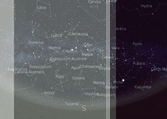 | click to fall sky, the band of Milky Way-embedded, typical, southern constellations. retrieve a printer-friendly chart |
All the sky between the band of the Milky Way-embedded constellations and the southern horizon further is filled with typical, southern constellations. You won't miss to spot them, like Pavo, the Peacock, Octans, the Octant, Mensa, the Table or Pictor, the Easel for a first, low row (and from the southeast to the southwest), as Apus, the Bird of Paradise, Chamaeleon, the Chamaeleon, or Volans, the Flying Fish are higher. Pyxis, the Ship's Compass and Musca, the Fly, are seen too, just lining the Milky Way. Both the Magellanic Clouds are adding to those remarkable, southern views! The fall sky, in the southern hemisphere, is treating us with much objects still, on the other hand! Omega Centauri (NGC 5139) is a famed globular cluster shining at the 3,7th magnitude, to the upper left of Crux, the Southern Cross. It's found on the line Agena-e Cen, at a little less the distance between both. 47 Tucanae is another globular cluster (NGC 104), at the 4th magnitude, which is just left of the Small Magellanic Cloud. The 'False Cross', found at the frontiers of Carina, the Ship's Keel and Vela, the Ship's Sails, is a set of stars which may be seen under the form of a cross
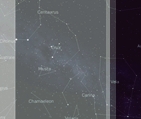 | 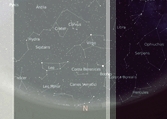 | click to fall sky, Omega Centauri and the False Cross (above) and the northern horizon (bottom). retrieve printer-friendly charts (Omega Centauri and the False Cross, northern horizon) |
With some time left -or another night- we now may consider the other horizon, West and North mainly. Let's turn West! With the band of Milky Way-embedded constellations southwest, another fine sight -albeit much fainter, is provided through the long and delicate chain of Hydra, the Hydra. Hydra's head is lying lower, near the horizon, a much fine view! Much high, at the contrary, you'll be able to spot how, from the zenith, three small constellations are anchoring to Hydra, with Corvus, the Crow, Crater, the Cup, and Sextans, the Sextant. The northern horizon is of interest too, with weaker fields, albeit of interest. Two bright stars -and maybe three- are conspicuous over the northern horizon. Due North, high, Spica, of Virgo, is to be found, with to its lower right, Arcturus, of Bootes, the Hersdman. Both those stars are famed, in the northern hemisphere because an astronomical saying tells that 'Arc to Arcturus, speed on to Spica', meaning that the northerners, taking at the Great Dipper, that emblematic asterism of the northern skies, and following the curve of the Dipper's handle will easily find Arcturus, then Spica. The saying is of no avail South, due to that we don't have the Dipper. Those with a plain horizon, will however be able to spot, the Great Dipper's handle, justly! It's those three or four stars barely above the horizon. Another remarkable sight and thought. Should you turn northwest now, you'll be able to spot another famed, zodiacal constellation. Leo, the Lion, which -a northerner would say- is lying upside down. Leo, the Lion, is a lion, fallen from the Moon like a meteor, that the Greek heroe Hercules had to fight. The two bright stars of Leo are Regulus, left, and Denebola, right, with a curve of stars -an asterism- taking at Regulus which is called the Leo's Sickle. Of note for the more advanced, and instrumental observers, that that season is prone for the deep-sky fields which are found in Coma Berenices, the Berenice's Hair, and Virgo. Those regions of the sky are where one may reach to the farthest reaches of the Universe, outside the Milky Way Galaxy plane!
Here you are! We explored the southern skies, along the seasons! Those skies, for most of them, were unknown when the first European explorers came to those southern seas and lands, keeping going further South. They were the first to see those stars. Scientists came then, who added new constellations to those that the Greeks already were seeing at the limits of their world. Welcome in the world of the southern hemisphere amateur astronomers. Should you feel that some parts of the sky are still badly understood to you, do not hesitate to come back to some parts of this page and to deepen your skills. On the other hand, each month, on this site, at the "Monthly Sky" section, you will find a view of the monthly western and eastern horizons. This will provide you with further insights as other tutorials about observation or about theory are helpful too
Website Manager: G. Guichard, site 'Amateur Astronomy,' http://stars5.6te.net. Page Editor: G. Guichard. last edited: 12/28/2010. contact us at ggwebsites@outlook.com